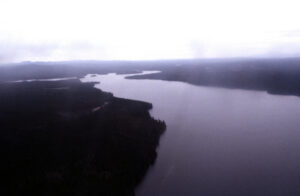Living in Nimpo Lake
May 19, 2023 By: T00109988
Location: https://www.google.com/maps/place/52%C2%B019\'59.0%22N+125%C2%B010\'39.0%22W/@52.3330589,-125.1800749,17z/data=!3m1!4b1!4m4!3m3!8m2!3d52.3330556!4d-125.1775

Living in Nimpo Lake, BC
I live in the supreme plateau of Nimpo Lake BC in a small First Nations Community of Ulkatcho First Nation on Indian Reserve #19. There is 14 of my family members living on this small reserve, not on the main reserve in Anahim Lake, BC. There is in total 8 houses and 4 single units for small families. The population is shared with of 1500 people with our neighboring town of Anahim Lake, BC.[1] We all have private wells for water, and rely on BC Hydro for power. Nimpo Lake is a lazy town with one store and one café for the public. There is plenty of fish and wildlife that can be harvest with the seasons, there is many farms and ranches, and jobs in logging and mining. I enjoy harvesting and preparing traditional medicines, following my ancestor’s culture and rarely rely on store bought medicines. I harvest pine, balsam, spruce, balsam pitch sap, juniper, soup berries, to name a few trees and plants. Our people also use the branches to burn for scared reasons. I will focus my paper on traditional medicines and when and where to find the trees and plants.
I grew up in a tiny little town of Nimpo Lake, BC which is located 300 kilometres west of Williams Lake, which shared a population with Anahim Lake, BC of 1500 people. Nimpo Lake has various fresh fish such as, Rainbow Trout, Dolly Varden, and Bull trout.[2] Back in the mid 70’s, as I remember there were only a few hundred First Nations, and non-first nation ranchers in the area depending on ranching for income. As a proud Ulkatchot’en we depended on the land and the season for harvesting food, and medicines within our traditional lands.[3] As the climate was harsh in the Winter with the temperature that can reach minus 50 below and having a late spring in May. The ground was hard clay and it was hard to make a garden, my ancestors relied on living off the land with the seasons, and what nature had to provide us.
In the late spring my family use harvested strips of cambium from the inner bark from the lodge pine trees for protein and food.[4] This was a treat to the families that had to eat moose or elk throughout the winter with no fruits or vegetable. We use to harvest the sap from the bark with had a strong smell of pine and was used for various medicines such as, tooth aches, cuts, bruises, and infections. In the Spring we use to go higher up in the mountains and harvest Balsam bark to prepare tea for stomach infections and sore bones, and make salve from the bark to sooth arthritis and sore bones. These are the two biggest tree healers for colds, flus, and infections.
In the summer we use to harvest juniper berries and use them to make a tea after the long winter which had a strong taste but was delicious and healed stomach aches.[5] The berries should be a dark purple in color to be in fourth year growth, which would be ripened, and ready to harvest and prepare for medicine. The salve was made from the ripened juniper berries with Vaseline or coconut oil, which was boiled and rendered and made into a salve. Ulkatcho People used the salve for arthritis and sore bones. I have been making this remedy for the last 45 years and know use it after a long hard day at work to sooth my sore bones from typing on the computer all day. We also harvest soup berries that was harvested in the mid- summer, which is used for stomach aches, and cleans the stomach as a laxative.
In the winter we look forward to having rabbit and wild birds for a special treat, which I find taste better then chicken. In the summer there is an abundance of fish that can be harvest for the winter. In the late fall we use to hunt moose and deer to have enough meat to make it throughout the winter. As Ulkathot’en we rely on the land for food, and never rely on the grocery stores as it’s all available year round.
In summary my people of the Ulkatcho Village rely forest for foods, cambium, and traditional medicines. We depend on the trees and plants that we harvest through the seasons of the calendar, that are good for the organs and skin to heal infection faster than ointment from the stores. Everyday harvesting trees and plants with my elders is a learning experience that I have been handing down to my son, and grandchildren for their own personal use.
Bibliography
“Anahim Lake.” Wikipedia. Accessed May 10, 2023. https://en.wikipedia.org/wiki/Anahim_Lake.
Birchwater, Sage. Ulkatcho Food and Medicine Plants. Anahim Lake, BC: Ulkatcho Publishing, 1996.
“Nimpo Lake.” The Land Conservancy. Accessed May 10, 2023. https://conservancy.bc.ca/featured-projects/nimpo-lake/.
[1] “Anahim Lake,” Wikipedia, accessed May 10, 2023, https://en.wikipedia.org/wiki/Anahim_Lake.
[2] “Nimpo Lake,” The Land Conservancy, accessed May 10, 2023, https://conservancy.bc.ca/featured-projects/nimpo-lake/.
[3] Sage Birchwater, Ulkatcho Food and Medicine Plants (Ahahim Lake, BC: Ulkatcho Publishing, 1996), 2.
[4] Birchwater, 14.
[5] Birchwater, 46.